Abstract
Let Pfaffian system ω define an intrinsically nonlinear control system on manifold M that is invariant under the free, regular action of a Lie group G. The problem of identifying and constructing static feedback linearizable G-quotients of ω was solved in De Doná et al. (2016). Building on these results, the present paper proves that the trajectories of ω can often be expressed as the composition of the trajectories of a static feedback linearizable quotient control system, ω/G, on quotient manifold M/G, and those of a separate control system, γ G, evolving on a principal G-bundle over a jet space. Furthermore, we point out that ω may not only have a static feedback linearizable quotient, ω/G but additionally, γ G itself may possess a static feedback linearizable reduction as well. This enables one to express the trajectories of an intrinsically nonlinear control system as the composition of the trajectories of static feedback linearizable control systems, thereby providing a geometric criterion for the explicit integrability of intrinsically nonlinear systems. Moreover, special integrability properties arise when G is solvable. Examples are presented in which the above phenomena are explicitly demonstrated. An important aspect of the examples is that they gather evidence for the conjecture that our sufficient conditions for explicit integrability are also necessary.
Similar content being viewed by others
Notes
We will say that (2) is not explicitly integrable; see Definition 1.
The term “cascade static feedback linearizable” will be elucidated in the next section.
The notion of “reduction” here is explained in Section 2.1.
4Sometimes “partial prolongation” is used as a noun as it is here.But sometimes, it is used as a verb as in “a partial prolongationβ 〈1〉has been executed to produce β 〈0,1〉.”
References
Anderson IM, Fels ME. Exterior differential systems with symmetry. Acta Appl Math 2005;87:3–31.
Anderson I M, Torre C. 2015. The DifferentialGeometry Package Downloads (2016). Paper 4; http://digitalcommons.usu.edu/dg_downloads/4,.
Bloch A M. 2015. Nonholonomic mechanics and control, interdisciplinary applied mathematics. Springer-Verlag.
Brunovsky P. A classification of linear controllable systems. Kybernetika, cislo 3, rocnik, 6/1970.
Bryant RL, Vol. 1. An introduction to Lie groups and symplectic geometry. In: Geometry and quantum field theory, (Park City, UT, 1991), IAS/Park City Math. Ser. Providence: Amer. Math. Soc.; 1995.
Bryant RL, Chern SS, Gardner RB, Griffiths PA, Goldschmidt H. Exterior differential systems.
Cariñena J F, de Lucas J. Lie systems: theory, generalisations, and applications, Dissertationes Mathematicae 479, 162 pp., Institute of Mathematics. Warszawa: Polish Academy of Sciences; 2011.
Cartan E. Les systémes de Pfaff, à cinq variables et les équations aux derivées partielles du second ordre. Ann Sci École Norm Sup (3) 1910;27:109–192.
Charlet B, Lévine J, Marino R. On dynamic feedback linearization. Syst Control Lett 1989;13:143–151.
De Doná J, Tehseen N, Vassiliou P. Symmetry reduction, contact geometry and partial feedback lineari- zation, https://www.researchgate.net/profile/Peter_Vassiliou; to appear in SIAM J Contr Optimiz. 2016 .
Doubrov BM, Komrakov BP. The constructive equivalence problem in differential geometry. Sb Math 2000;191:655–681.
Elkin V I. Reduction of nonlinear control systems: a differential geometric approach, series: mathematics and its applications. Springer-Verlag; 1999. Vol. 472.
Grizzle J, Marcus S. The structure of nonlinear control systems possessing symmetries. IEEE Trans Autom Control 1985;30(3):248–258.
Hauser J, Sastry S, Meyer G. Nonlinear control design for slightly nonminimum phase systems: application to v/stol aircraft. Automatica 1992;28:665–679.
Krener A J. A decomposition theory for differentiable systems. SIAM J Contr Optimiz 1977;15:813–829.
Krener A J, Isidori A, Respondek W. Partial and robust linearization by feedback. In: Proceedings 22nd IEEE conference on decision and control; 1983. p. 126–130.
Levine J. 2009. Analysis and control of nonlinear systems: a flatness-based approach. Springer Science & Business Media.
Marino R, Boothby W M, Elliot D L. Geometric properties of linear controllable systems. Math Systems Theory 1985;18:97–123.
Marino R. On the largest feedback linearizable subsystem. Syst Control Lett 1986; 6:345–351.
Martin P, Devasia S, Paden B. A different look at output tracking: control of a VTOL aircraft. Automatica 1996;32(1):101–107.
Martin P, Rouchon P. Feedback linearization and driftless control systems. Math Control Signals Syst 1994;7:235–254.
Nijmeijer H. Feedback decomposition of nonlinear control systems. IEEE Trans Automat Contr 1983;AC-28:861–862.
Olver P J. 1986. Application of lie groups to differential equations. Graduate texts in mathematics. Springer-Verlag.
Palais RS. 1957. A global formulation of the lie theory of transformation groups. Mem. Amer. Math. Soc. American Mathematical Society.
Respondek W. On decomposition of nonlinear control systems. Syst Contr Lett 1982;1:301–308.
Vassiliou P. A constructive generalised Goursat normal form. Diff Geom Appl 2006; 24:332–350.
Vassiliou P. 2006. Efficient construction of contact coordinates for partial prolongations. Found Comput Math, 269–308.
Vassiliou P. Contact geometry and control, advances in the theory of control, signals and systems with physical modeling. Lecture notes in control and information sciences. In: Levine J and Müllhaupt P, editors. Springer-Verlag; 2010.
Author information
Authors and Affiliations
Corresponding author
Rights and permissions
About this article
Cite this article
Vassiliou, P.J. Cascade Linearization of Invariant Control Systems. J Dyn Control Syst 24, 593–623 (2018). https://doi.org/10.1007/s10883-017-9389-0
Received:
Revised:
Published:
Issue Date:
DOI: https://doi.org/10.1007/s10883-017-9389-0
Keywords
- Lie symmetry
- Contact geometry
- Static feedback linearization
- Dynamic feedback linearization
- Trajectory decomposition
- Integrability




